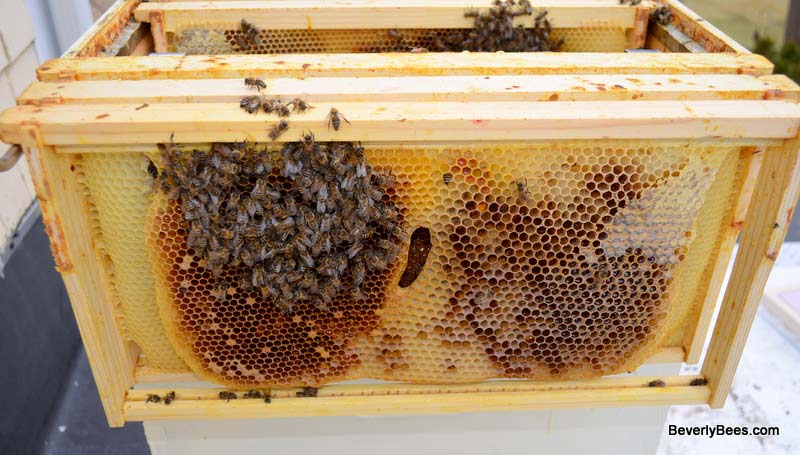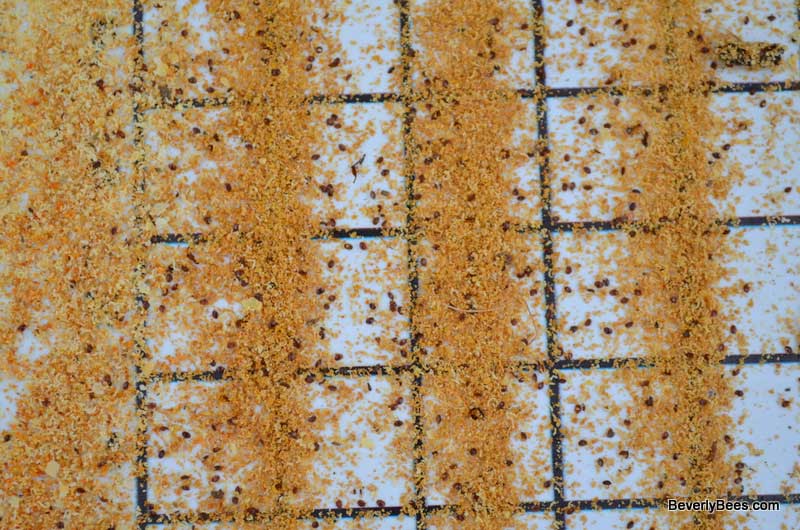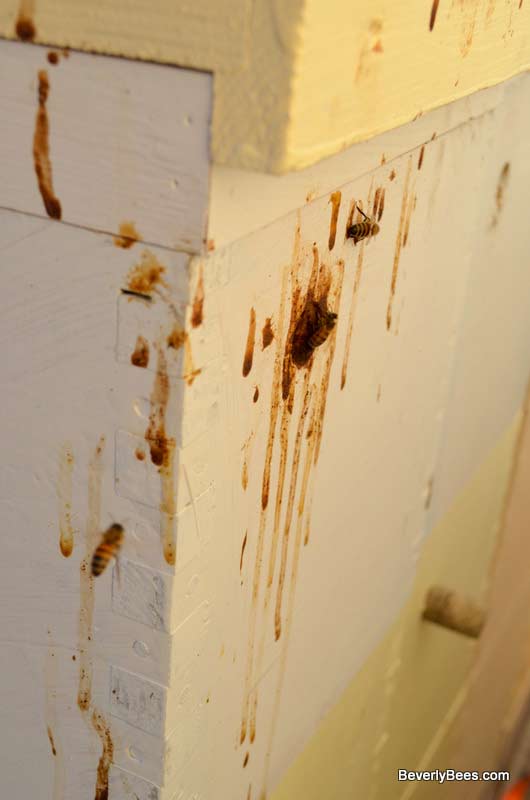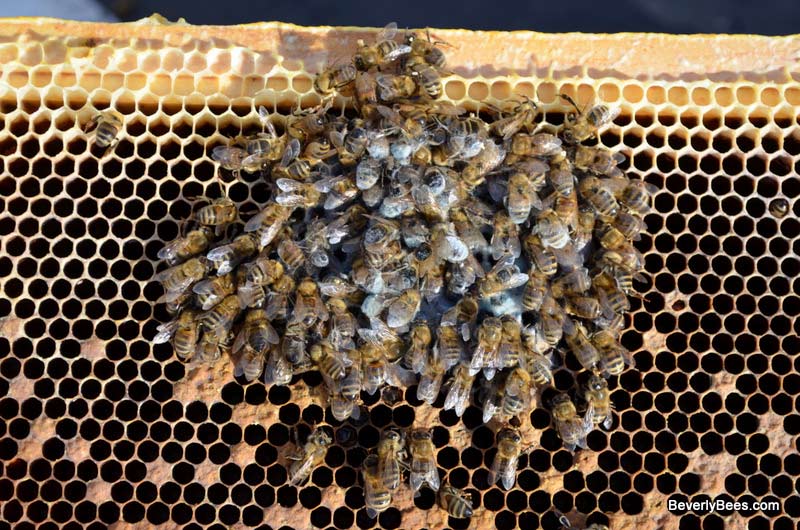what to do with a dead bee hive
How to Autopsy a Honey Bee Colony
By Anita Deeley at BeverlyBees.com
So your hive died, now what do you exercise? The first thing to do after y'all discover a dead hive is to autopsy a honey bee colony and look for signs of disease, varroa and anything else you lot think may accept caused the colony's demise.

Information technology important to notation the time of year your hive died. If your hive died over the winter it may have died from condensation, starvation or common cold which is typical in a winter killed hive. Nosema Apis is also more mutual in the winter when bees cannot become exterior to defecate regularly. If your hive collapsed in the autumn, varroa could exist the culprit as the population of varroa is usually highest then. Performing an autopsy of a honey bee colony is like solving a mystery and a variety of clues must be establish and taken into business relationship together, before yous tin can make a final analysis of what happened to your hive. Here are some other basic clues to await for.
Does the colony accept a queen, are eggs and open breed in the cells? Is the brood mostly drones? Are in that location many emergency queen cups or cells?
A colony without a queen, eggs or brood and many emergency queen cups or cells may have lost their queen and were unable to replace her. If the queen is present in the hive but expressionless, and it is not a winter kill, there should be eggs in the cells and open brood. If in that location are no eggs or open brood, the colony may have died from queen failure. A large number of drone cells may indicate queen failure or laying workers if the queen is absent.
Practise you see a lot of varroa on the lesser board or on capped brood when yous remove them from their cells for inspection?
If so, your hive may have suffered from varroa collapse.

Practice the bees that died look healthy or are they plain-featured with short abdomens and missing or stubby wings?
Plain-featured bees with chubby abdomens and missing or deformed wings may have plain-featured wing virus which is unremarkably spread from varroa. Look at the bottom board for signs of varroa, the combs for white varroa carrion, and pull some capped breed to examine them for varroa infestation.
Are there many dead and dying bees in front end of the hive? Do the bees have their tongues sticking out?
Your bees may take been poisoned with pesticide. If you want to transport them in for testing, collect as many bees as you can, preferably ones simply dying and freeze them every bit soon as possible. Freeze your combs with pollen stores. Pesticide dissipates very quickly and samples must be frozen as soon as possible to preserve the integrity of the chemicals. Telephone call the Columbia Food Laboratories to inquire about testing for pesticide poisoning. Here is a proficient resource from the University of Florida about pesticide poisoning and honey bees.
Are the bees hairy or greasy and black looking?
Greasy, black bees may accept a paralysis virus such equally chronic bee paralysis or some other disease. You may want to send them in for testing or ask for help from your apiary inspector.
Exercise any of the bees take wings separated making the shape of the letter One thousand?
Your hive may be infected with K Wing which can be caused from Varroa, Trachael Mites, Nosema and more than. More investigation will need to exist done.
Did the bees die with their heads in the prison cell, butts sticking out, away from honey stores? Was the weather condition previously cold?
Your bees may have died from starvation. This happens often in common cold weather when the hive is unable to break cluster to move to their stores. This is common in a winter killed hive.
Is there honey and pollen in the hive? Are there many expressionless bees with their caput in the cells?
If there are non adequate stores, your bees may have died from starvation. Starvation can and does happen in the summer with flowers blooming if no honey is in the hive.
How many bees are left in the hive? Are the dead bees within the hive or outside on the footing in front of the hive?
Lots of dead bees outside the hive tin betoken a number of factors including starvation, pesticide poisoning, affliction, moisture, etc. Lots of dead bees inside the hive tin also indicate a number of things as well, winter kill, starvation, pesticide, disease. You need to look for other clues. If you lot have access to a more than experienced beekeeper or apiary inspector information technology does not hurt to get a second opinion.
Are there few dead bees in the hive with only a handful of bees, breed and the queen remaining? This hive may take suffered from Colony Collapse or Varroa Plummet. Wait for other symptoms. Are many varroa present on the capped breed or the bottom board?
Perhaps varroa killed your bees. If you accept other hives and this hive is non getting robbed out, yet resources are scarce, your bees may take suffered from Colony Collapse Disorder.
Does the brood look good for you or is information technology discolored and contorted? Does information technology aroma? Does information technology look melted? What does the brood pattern await like?
A spotty brood blueprint is common in declining hives. The reduced number of bees cannot go along up every bit the population hits a death spiral. If the breed is discolored or smells, it could be old brood, breed that got chilled or something more than serious like European or American Foulbrood. Information technology is all-time to send these samples away for assay before using these combs. If information technology is EFB or AFB combs may need to exist irradiated, discarded or burned. It is best to speak with an apiary inspector to find out what the rules are in your country for treating this disease. For photos of EFB, click here.
Are the capped brood punctured with holes and sunken in?
This could be a symptom of varroa or some other disease such as American Foulbrood. Look for more clues. You lot may want to send your bees in for testing.
Are there brown or yellow stains all over the outside of the hive and the hive opening and/or within the hive?
This could exist dysentery or nosema. Yous may want to transport your bees in for testing.

Are there trembling bees itch effectually outside the hive?
Your bees may accept a multitude of diseases such equally varroa collapse, several types of virus, starvation or pesticide poisoning. You may want to send them in for testing.
Does the larvae string out if you insert a toothpick into the cell?
Your bees may have American Foulbrood and combs cannot usually be reused. Ship your comb in for testing and/or speak to an apiary inspector, a more experienced beekeeper, or your local bee club. Combs and equipment may need to be burned or irradiated to kill the spores from this disease and proceed it from infecting other bee colonies.
Are there many bees with their heads in the cells away from beloved stores? Did your hive dice over the winter or the summer?
Your bees may have died from starvation, common in winter killed hives.
Does the hive seem wet, is at that place a lot of moisture in the hive? Is there mold in the hive?
Condensation may accept killed your bees. Wet, cold bees are expressionless bees. Try to ventilate your hives better to allow more air circulation. Check to see that equipment is intact and h2o cannot get into the hive. Cheque for mold and mildew in the hive, these may too be indicators that your hive needed more ventilation.
Here is a good link showing unlike types of bee diseases and so you have a reference for what to wait for and how to self diagnosis your hive. If you are new to beekeeping I highly recommend asking an apiary inspector or a more than experienced beekeeper for help in determining what happened to your hive.
At that place are as well many helpful bee links on this website on the Resource page as well every bit the right sidebar called Helpful Bee Links that may help you diagnosis what is wrong with your bees. Often times when a hive gets weakened, many different symptoms volition show up as the hive is less able to take care of itself. In this situation diagnosing what was the bodily killer was can exist confusing. If your hive is infested with wax moths or wasps, these are opportunistic parasites and usually take reward of already weakened hives. Strong hives are usually able to go along them at bay. If you lot run across these pests, it is non likely the cause of your colonies death. The same is true of mold. If you find mold on your bees or combs, information technology simply means the bees have been expressionless for a while and were unable to care for the hive, it does not mean mold killed your hive. Information technology may nevertheless also be a inkling that this hive could have been killed past backlog condensation and next time you should endeavor to give your hive more ventilation.

If you think there is disease in the combs or bees, or think your bees may have perished from Varroa y'all can submit a sample to the Bee Lab in Beltsville, Physician to test for this. It is complimentary for U.s. residents and will take a few weeks to become results dorsum. This lab does non test for viruses or pesticides and does not distinguish betwixt nosema strains, only identifies if nosema is present. If you would like to reuse your combs in some other colony without worrying about if they are infected with a contagious bee disease information technology only takes a few minutes to prepare and mail in a sample.
Other Posts Yous May Enjoy:
- How To Ready A Sample For Bee Illness Diagnosis or Pesticide Analysis
- Decease of a Hive: A Postmortem Analysis
- Mass Bee Field Twenty-four hours 2012
- And so Many Bees, Then Little Love
- Ahhh Mites! Treating For Varroa Destructor
- I Want Candy! Then Let's Make A Candyboard For Wintertime Feeding
Other Pages You May Enjoy:
Source: https://www.beverlybees.com/beginner-beekeepers-guide/how-to-autopsy-a-honey-bee-colony/
0 Response to "what to do with a dead bee hive"
Post a Comment